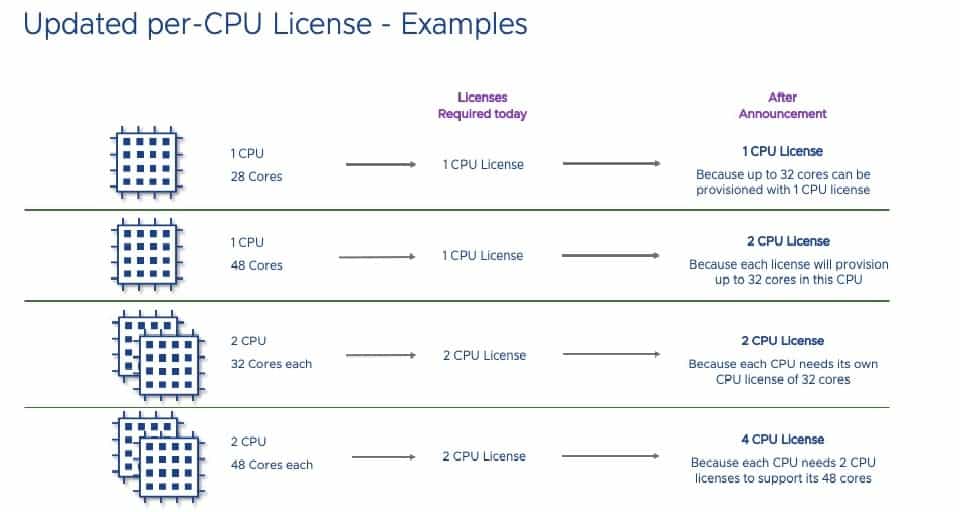VMware announced a significant change to its licensing per CPU. This entire change took effect on April 2, 2020.
Keeping in mind before any technical analysis that VMware has never been concerned with the number of cores in each CPU and so should be the last of the big manufacturers to maintain a metric of processor per physical CPU. Most of them have already moved to licensing using more complex factors and indexes to calculate required licenses.
This change can impact the way your company provisions environments and especially how it plans to adopt hybrid clouds. Planning without taking into account public clouds or resources such as VMware Cloud on AWS can double the cost of VMware CPU licensing for customers with more than 32 cores.
VMware never worried about the number of cores in each CPU, now is the time
But what has changed?
In cases of processors running VMware with less than 32 cores, nothing changes. If these have more than 32, an extra license will be needed for the next 32 and additional licenses for each subsequent block of 32.

We know that AMD and Intel they already have chips with up to 64 cores, but it probably won't be long before we're talking about 96 or even 128 CPUs. It's worth mentioning that AWS, Google and Azure already have instances with 96 vCPUs.
How can I benefit from this now?
VMware is making a gradual move at no immediate cost, but to get this “benefit” you need to make some quick decisions and actions! If you don't make the changes now, the costs are bound to arrive in 2021.
For those customers who are already running VMware on CPUs with more than 32 cores per chip, or are planning to purchase soon, they can apply for the benefit of additional licenses at no charge, either through their software reseller or directly to VMware.
I will be able to use this “benefit” if:
- Make the formal request for the benefit by January 29, 2021;
- If my servers and licenses were purchased before April 30, 2020. Please keep all hardware and software acquisition documents following the rules of Software Asset Management.
- I have a contract with SNS (VMware Technical Support and Subscription Services) active in the original licenses and contracted before April 30, 2020.
The burden of this benefit is that when you renew your support contract with VMware, you will normally be billed and supported for the additional free licenses you received under this “benefit”.
Our recommendation:
These changes in the rules of licensing they can be tracked and managed by a Center of Excellence in Software and Cloud Governance (CCoE). You can use a single hybrid cloud governance platform, where you can control the costs of your VMware datacenter as well as AWS, Azure and Google public clouds.
It is very common that companies only pay attention to the datacenter licensing architecture after the migration and that is why our work methodology shows that this study has to be done together with the technical architecture.
We are 4Matt Tecnologia, specialists in Software Governance and Cloud Spend Management.
Tag: vmware vsphere, distributed switch, vcenter server, enterprise plus, virtual machine, management enterprise, physical processor, fault tolerance, auto deploy, vmware vcenter, mato Grosso, vsphere with operations management,
storage vmotion, drs distributed, essentials plus, distributed resources scheduler, high availability, enterprise standard, vsphere standard, server consolidation, vsphere essentials, vmware editions, vshield endpoint,
vmware vsphere with operations, distributed power management, host profiles, ip phones, vmware products, vmware licenses vsphere, hp servers, vmware esx, virtual machines, vmware license, network card, vmware horizon, vmware esxi, social networks, licensing vsphere, vsphere desktop, dell servers, product licensing, vcenter license, it infrastructure, cloud virtualization, vcenter server standard, vsphere physical server licensing, operations management, Finops, Software Asset Management, Software Asset Management, ServiceNow, CloudHealth
